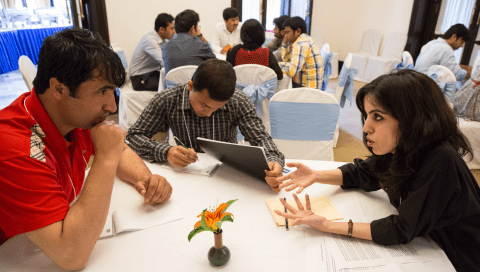“Because social media policies tend to focus on how posts get perceived rather than how they are written in the first place, enforcement most frequently occurred when the online audience was upset about something.”
By NASEEM MILLER Feb. 9, 2023, 1:49 p.m.
Journalists are often encouraged to be active on social media and engage with their audiences, but their newsroom social media policies do little to protect them when they’re attacked or harassed online, according to a recent study that adds to a growing body of research based on surveys of reporters and editors across North America.
Women and journalists of color are particularly vulnerable to these attacks, notes Jacob Nelson, an assistant professor in the Department of Communication at the University of Utah, and author of a recent study, “‘Worse than the Harassment Itself’: Journalists’ Reactions to Newsroom Social Media Policies.”
His study, published last month in Digital Journalism, is based on in-depth interviews with 37 reporters, editors, publishers, freelancers, and social media and audience engagement managers in the U.S. and Canada, who were current or former employees of local, national, for-profit, nonprofit, print, digital and broadcast outlets.
It’s worth noting that Nelson’s study may or may not apply to other countries, as newsroom cultures and approaches to social media, free speech and online harassment varies depending on the country. It also focuses on how journalists perceive their newsroom’s social media policies, rather than textual data collected from the policies themselves. In addition, not all the journalists voiced the same criticisms of their newsrooms, he notes.
But his findings echo what previous small studies based on interviews with journalists have found, highlighting the complicated role of social media in journalism today. While many journalists find platforms like Facebook and Twitter invaluable in their reporting, they also see them as dangerous and unsettling places. And while many newsrooms encourage journalists to have a presence on social media, they do little to protect them when they’re trolled or attacked online.
Several studies in recent years have urged news leaders and organizations to find ways to protect their journalists when they’re harassed online.
“The Chilling: A Global Study of Online Violence Against Women Journalists,” published by the International Center for Journalists in November 2022, is a three-year study among 1,100 participants covering 15 countries, including the U.S., which finds 73% of respondents identifying as women said they experiences online violence. Black, Indigenous, Jewish, Arab, Asian and lesbian women journalists participating experienced the highest rates and most severe impacts of online violence. The authors emphasize the role of various entities, including news organizations, in developing “gender-aware protocols to respond to online violence, stop victim-blaming, and avoid disproportionate restraint on the speech of women journalists when they come under attack.”
A 2021 study published in Journalism Practice, based on interviews with 31 U.S. journalists finds “almost no system-level interventions regarding harassment from audiences on social media or journalists’ long-term mental health.”
The authors of that study find journalists face three types of harassment: “acute harassment such as generalized verbal abuse, chronic harassment occurring over time and often from the same social media users and escalatory harassment that is more personalized and directly threatening.” Women were most likely to experience chronic and escalatory harassment, the authors write.
Studies have shown that online harassment of journalists — particularly women journalists and journalists of color — can affect their mental health.
In the commentary “What will it take for newsroom leaders to support and defend journalists?” published in September 2022 in Journalism & Communication Monographs, Tracy Everbach, a journalism professor at the University of North Texas, writes, “It shouldn’t require someone vandalizing a supervisor’s house to get newsroom leaders’ attention. We all bear responsibility for preparing, training, placing, and retaining journalists in safe and inclusive environments.”
Walking a “tightrope”
In many newsrooms, journalists are encouraged or even required to have a presence on social media and build an audience for themselves and the news organization. Many journalists also find social media an integral part of their reporting to find sources, connect with their community, and even galvanize efforts such as union drives.
At the same time, newsroom social media policies can be confusing for journalists who want to be more authentic in their posts and interact with their audience.
Nelson quotes several journalists in his study.
Shree Paradkar, a social and racial justice columnist for the Toronto Star, told Nelson, “On social media, we are told to have your own voice because [the news organization] recognizes that, if you’re on social media, then your authenticity is really important if you want to have more followers….Have your own voice, but don’t use certain language, certain words….There’s a lot of policing of language. How can you have your own voice when you have all these restrictions?”
It’s a tension between mass media’s focus on neutrality and independence, and social media’s rewards for authenticity, popularity, and connectivity, Nelson writes.
And even if a journalist strictly follows a newsroom’s social media guidelines, no amount of policing and policy can predict how the public is going to respond to a post or a tweet.
As a result, many journalists end up having to navigate a “tightrope,” where the social media platforms they depend on are accompanied by the very real risk of professional, physical, and emotional harm, Nelson writes.
His interviewees expressed deep frustration that they couldn’t control when they might face punitive measures from their newsroom managers for something they posted, because they couldn’t predict what might cause the online audience to perceive something undercutting the neutrality of their publication.
They also were frustrated that the enforcement of newsroom social media policies focused on the organization’s credibility tended to skew unequally toward women and journalists of color.
“As the interviewees consistently explained, because social media policies tend to focus on how posts get perceived rather than how they are written in the first place, enforcement most frequently occurred when the online audience was upset about something,” writes Nelson. “And because the online audience tended to get more upset more often at things posted by women journalists and journalists of color, those journalists paid professional penalties for their use of social media more often than their male, white counterparts.”
In their own words
Nelson’s 37 interviewees included 22 women and 18 journalists of color. They were based in print and digital newsrooms in the U.S. and Canada. One was based in the U.K. The interviews were conducted between July and September 2021 via Zoom.
Nelson lists four key findings from his interviews. Considering the risk of professional consequences, the interviewees could choose to be quoted by name, anonymously, or not at all. They also had a chance to review their quotes.
Participants consistently said social media platforms, particularly Facebook and Twitter, played an integral role in their work. Sewell Chan, editor-in-chief of the Texas Tribune, told Nelson the potential for bringing new audiences to journalism was one of the biggest draws of social media platforms.
“When I’ve talked to journalists about reasons to be on social media, I have emphasized that, at the very, very least, you need to recognize at the point your content is published, that’s actually the beginning of a process, not the end of a process,” Chan told Nelson. “We are in the fight for our lives, for the lives of our institutions, and we need to find readers wherever they are.”
Renata Cló, Arizona schools reporter with The Arizona Republic, told Nelson that social media “gives us an opportunity for people to easily reach out to me and say what they think of my story or leave a suggestion or a criticism to my story or something I hadn’t thought about. When people call me or send me an email about any story, they are usually very mad, and they are very disrespectful. [When I respond to them,] it’s just a matter of me trying to tell people, ‘Hey, I’m not a robot.’”
Interviewees said online harassment was their biggest concern when using social media. One journalist told Nelson when she shared the news about her pregnancy on Facebook, she was thrilled by the thousands of positive comments at first. But when some of her followers realized she wasn’t married, people attacked her for being a “bad role model.”
“They wished death upon my child because I wasn’t married…They were so absolutely horrendous and that emotionally took a toll on me,” she said.
Another reporter, Barbara VanDenburgh, the books editor for USA Today, told Nelson, “It is scary…for people to be calling you a bitch or a whore, and to come after you on Twitter in a really personal way.”
When asked what their newsrooms did to help support them in the face of online harassment, many voiced dissatisfaction. One journalist summed it up to Nelson in one word, three times: “Nothing. Nothing. Nothing.”
Some said the social media policies of their news organizations did not include protections or resources for journalists facing either acute or recurring online harassment.
Jessie Shi, the former social media editor for the San Antonio Express-News, told Nelson, “Reporters are usually on their own when it comes to trolls.”
“The response to online harassment can genuinely be worse than the harassment itself,” Jamie Landers, a former health disparity reporter with Arizona PBS, and a former breaking news reporter with the Arizona Republic, told Nelson.
“You’re constantly told to ‘tough it out,’ which is possibly the most immature piece of advice I’ve heard in my life,” Paradkar told him. “Because not only does it mean that you are not allowed to acknowledge the fear and pain, possibly trauma, depending on the level of abuse, but it also puts in place the ability for someone to do it again to somebody else.”
“This lack of interest in addressing the threats, harassment, and abuse journalists face — particularly women journalists and journalists of color — left some of the journalists I spoke with feeling as though their editors were implicitly suggesting that online abuse was just an inevitable part of working in journalism in an era of social media,” Nelson writes.
Interviewees told Nelson their newsroom policies focused on advising journalists how they should or should not use social media instead of telling them what they should do when they’re harassed online. “It’s pretty wild that there’s this double-edged sword where you’re not sure if you’re going to be punished for using social media, and yet you need to use social media in order to represent the outlet and the brand,” said Gabe Schneider, the editor of The Objective, told Nelson.
Carla Murphy, a former editor for The View from Somewhere podcast and board member of the Journalism & Women Symposium, said, “I think a lot of journalists feel like they’re out there on their own, and they are. They get hung out to dry. But then which journalists get hung out to dry? Some get hung out to dry more than others. Women, right? Black women. Black men. Some people get second and third chances. The penalties aren’t applied equally.”
Advice for news managers
“If I were to take this study to a newsroom, I would say, ‘Look, you’re not just looking at a crisis when it comes to your relationship with your audiences, but you’re looking at a labor crisis, because your journalists feel like they are being really left out in the cold by the policies,” Nelson told me.
“It’s very clear from these interviews that [the lack of policies] is creating ill will between journalists and managers, because they feel like they’re being pushed to do something that carries a risk, but then they’re not given any protection from the organization when it comes to combating those.”
The Media Manipulation Casebook, a research platform on misinformation and disinformation at Harvard Kennedy School’s Shorenstein Center on Media, Politics and Public Policy, which is also home to The Journalist’s Resource, offers several tips for newsrooms to support journalists targeted by online harassment:
- Provide every journalist with an annual check-up of their digital security, and prioritize those whose coverage puts them more at risk.
- Provide every journalist with a subscription to a password manager.
- Have at least one person in the newsroom or on call who is a digital security specialist.
- Regularly communicate to staff that your newsroom cares about their well-being and demonstrate it by offering reporters an intake mechanism for sharing when they’re undergoing harassment.
- Have a chain of support ready to help.
- Validate reporters’ experiences and provide places to communicate about their well-being safely.
- Build email filters that scan for racist, sexist, and bigoted language.
- Monitor and report the journalists’ social media threats for them.
Original Article – https://www.niemanlab.org/2023/02/newsrooms-handle-online-harassment-inequitably-journalists-say/?utm_source=whatsapp




